yogabook / asanas / baddha padasana
baddha padasana
„bound feet“
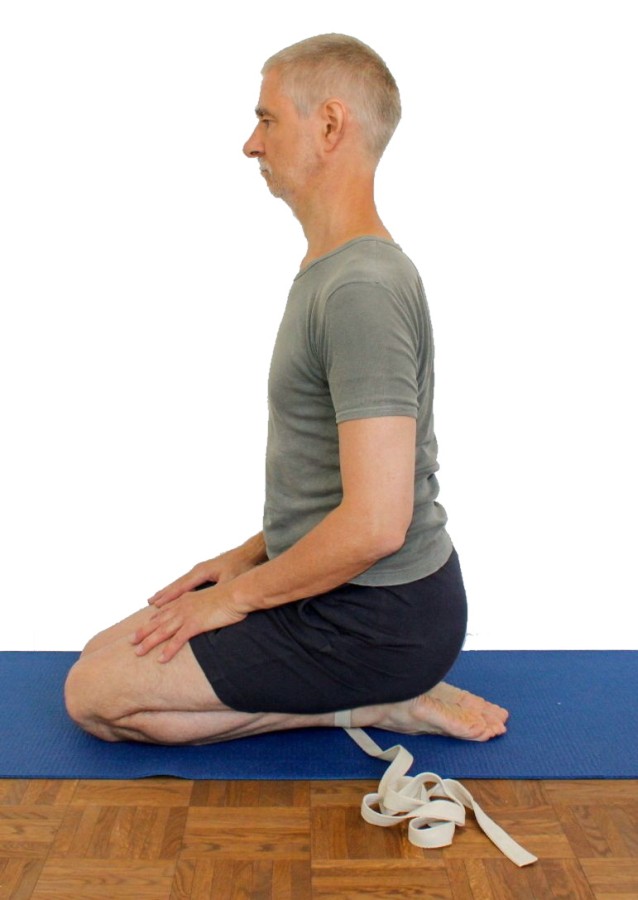
detail images
pull the belt tight with your knees closed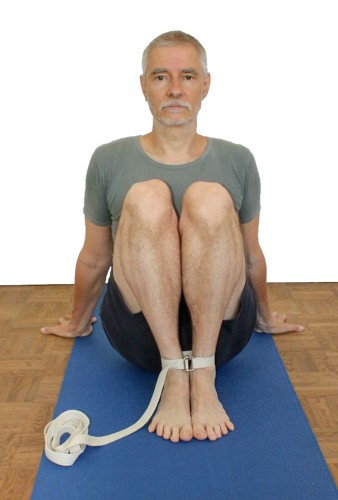 | only 3 mm between ankles when knees fall apart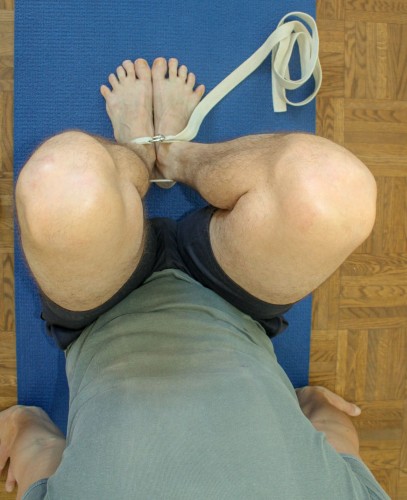 | do not sit with your hands supported on your heels, the sitting bones press your heels together and downwards; the belt is next to them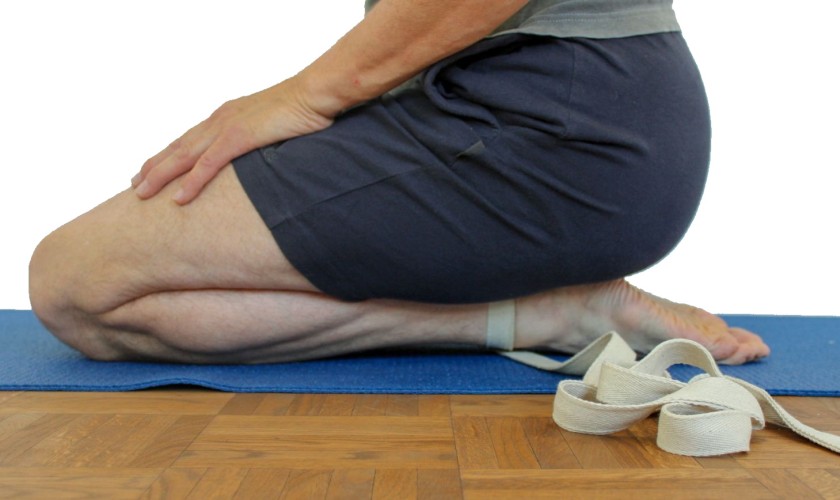 |
Feedback: We’d love to hear what you think about this description, give us feedback at:
postmeister@yogabook.org
Last modified: 30.12.2018
Name: baddha padasana
Trivial name: bound feet
Level: FA
- classification
- contraindications
- effects
- preparation
- follow-up
- derived asanas
- similar asanas
- diagnostics
- instructions
- details
- variants
Classification
classic: exercise
physiological: plantar extension of the ankles
Contraindication
Various types of knee conditions that do not tolerate extensive flexion of the knee joint under load are a contraindication for the standard version. In these cases, a customised version is recommended.
Effects
- (811) Stretching the quadriceps
- (841) Stretching the dorsiflexors of the foot
- (871) Stretching the pronators of the ankle joint
Preparation
If it is difficult to sit on the heels, this will be a result of excessive tension in the monoarticular parts of the quadriceps, which can help:
- virasana
- supta virasana, less than virasana
- quadriceps stretch 1 on the wall
- krouncasana
- tryangamukhaikapada pascimottanasana
As baddha padasana is probably the best exercise for stretching the ankles (plantar flexion) besides hip opener 5, general pre-exercises can be given, but none that practise this movement as precisely as baddha padasana:
- virasana does this if attention is paid to the extension of the ankle
- supta virasana also achieves this if attention is paid to the extension of the ankle, but has other, greater challenges
- „with upturned feet“ variant of the upface dog
- hip opener 5
Follow-up
If the calves feel tense or shortened after the pose or if the sole of the foot was close to cramp, these poses help:
Something can also be done if the backs of the legs feel shortened after the pose:
- uttanasana
- prasarita padottanasana
- parsvottanasana
- pascimottanasana
- janu sirsasana
- tryangamukhaikapada pascimottanasana
- downface dog
- hip opener 5
- warrior 3 pose
- trikonasana
- parivrtta trikonasana
derived asanas:
similar asanas:
Regarding the extension in the ankle:
- virasana does this if attention is paid to the extension of the ankle
- supta virasana also achieves this if attention is paid to the extension of the ankle, but has other, greater challenges
- „with feet upside down“ variant of the dog position head up
- krouncasana
- tryangamukhaikapada pascimottanasana
- hip opener 5
Diagnostics (No.)
The main cause of the inability to sit with the buttocks on the heels is tension in the monoarticular quadriceps. See above for how they can be stretched.
(950) Foot deformities:
In this pose, foot deformities may become apparent or have an effect on the pose, especially clubfoot and hollow foot.
(884) Knee:
In this position, knee problems associated with wide flexion under load become very apparent. These can be, for example: traumatic or degenerative meniscus damage, arthrosis/osteoarthritis, arthritis, subluxations, ligament damage, plica syndrome and others, see the FAQ.
(921) Ankle joint: extension deficit in plantar flexion:
In this pose, a stretch deficit will be noticeable in increased pressure at the typical four points:
- Medial edge of the metatarsophalangeal joint of the big toe (1st. ray)
- medial posterior calcaneus (heel bone)
- medial malleolar fork (distal tibia in the area of the talocrural joint)
- proximal end of the 1st metatarsal bone
The pressure is caused by gravity pushing the heels downwards and inwards. Restrictions in the flexibility of the dorsiflexors force the foot into increased inversion and cause the same pressure. The Achilles tendon area may also feel uncomfortable with a feeling of pressure or compression, similar to some people in trikonasana when the distance between the feet is rather wide.
(960) feet:
In this pose, misalignments (dislocations or subluxations) of foot bones, usually tarsal bones or the metatarsal bones in the neighbouring joints, can also become noticeable. In most cases, a side discrepancy and discomfort on the affected side is then perceived. In addition, in the case of hallux valgus, the metatarsophalangeal joint area of the big toe will show increased pressure pain.
(913) Cramp in the muscles of the sole of the foot or calf:
In this position, the sole of the foot is compressed; cramps in the sole of the foot can indicate previous (also chronic) overloading or incorrect loading and shortening of the muscles. Highly toned calf muscles can be prone to cramps.
Variants:
Instructions
- Sit cross-legged; place the feet in front of the pelvis so that the inner ankles touch; also bring the knees together.
- Tie the lower legs tightly together just above the ankles so that the inner ankles do not move more than 2-3 mm apart when you move the knees as far apart as possible (which cannot be far, as the belt limits their movement also).
- Then sit on your lower legs and, as in virasana, pull the undersides of your knees forwards so that the ankle can stretch optimally, preferably before and after lowering the bottom onto the heels.
- To begin with, transfer a little body weight to the floor with your hands and try to sit more and more on your heels, eventually sitting completely on your heels.
details
- This pose stretches the dorsiflexors of the ankle. Initially, however, the pressure between the inner ankles or between the metatarsophalangeal joints is often felt even more than the stretching sensation in these muscles. It can be quite intensive and can be perceived as very uncomfortable. There is nothing to be said against placing a small patch or a sock in between, for example, so that the pressure is felt less strongly. There are a total of four points that may feel strong pressure (see under diagnosis). The total amount of pressure is of course (together with other influencing variables such as body weight and any fatty tissue present) a measure of the inward (medial) evasive movements in the ankle, i.e. the resistance to plantar flexion in the ankle.
- As a rule, the plantar flexion of the foot achieved through this exercise is sufficient for all yoga poses and everyday life; only poses such as hip opener 5 with a large distance between the feet place at least the same demands on flexibility and can be perceived as somewhat more intense. If even more extension is required, baddha padasana can be practised with a slight elevation under the base of the toes.
- Make sure to hold the buckle of the belt in such a way that it cannot press on the lower legs, i.e. preferably centred between the lower legs.
- Bending the upper body forwards from the hip joints is of course a (usually quickly intuitively recognised) way of reducing the intensity of the extension requirement in the ankle joint, as shifting the body’s centre of gravity forward puts more weight on the knees and relieves the strain on the feet.
- The two ischial tuberosities should push the heels downwards and inwards to increase the extension demand and prevent the ankle from deviating towards supination in addition to the belt.
- In principle, a suitable, thin softening agent can be used between the feet if this does not impair the design.
- When taking the pose, as in virasana and supta virasana, pull the knees forwards to stretch the ankles and reduce the tendency of the soles of the feet to cramp. Whenever the position of the feet or knees has been changed, the knees should be pulled forwards again.
- Depending on the flexibility of the dorsiflexors and body weight, this pose can be extremely intense and support with the hands may be necessary.
- This pose improves the foot position in poses with virasana leg(s) such as virasana itself, supta virasana, krouncasana, tryangamukhaikapada pascimottanasana, so that the foot is less forced to move into adduction and supination in the ankle joint, which quite regularly leads to undesired rotation of the lower leg in the knee joint.
Known problems that can occur even when executed correctly
Pressure pain in the bony inner foot
As described above, significant to severe pressure pain can occur in up to four places (with normal foot shape), which makes it necessary to support part of the body weight with the hands
Cramps in the sole of the foot or calf
If such cramps occur, first stretch the sole of the foot and calves sufficiently before trying baddha padasana again. Different types of physical activity, prolonged standing or sport can increase the tendency to cramp. A fascia roll usually helps well against the tendency to cramp in the intrinsic foot muscles.
Variants
supported

Allows the execution of the pose in the event of excessive pressure pain
Instructions
- Take the pose as described above, but support yourself with your hands on the floor or on blocks as necessary.
details
- Support yourself by placing your palms or fists on the floor, but not just your fingers if then your base joints were hyperextended. If necessary, use blocks to support your palms.
For knee problems
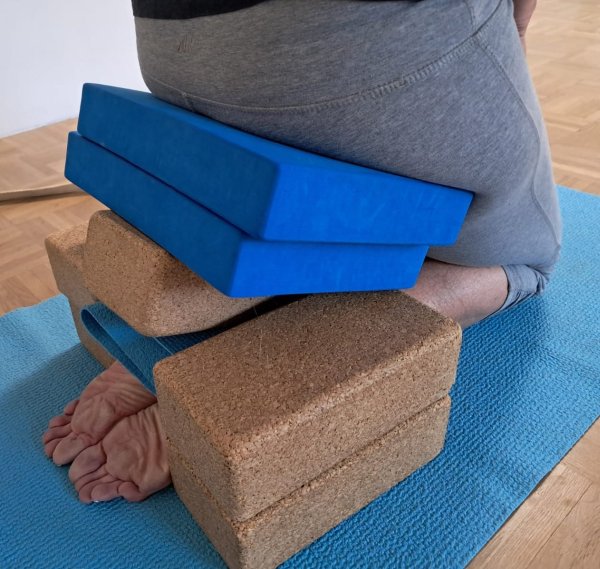
DON’T
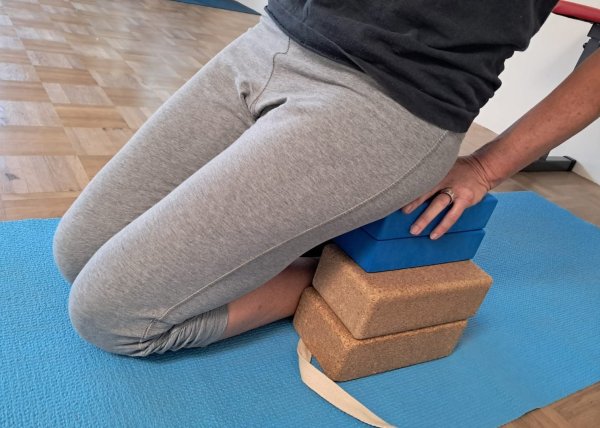
Instructions
- Assume the posture as described above, but do not rest your buttocks on your heels, but place enough aids between your buttocks and heels so that the knee joints only bend to a safe angle.
Details
- Various complaints of the knee joint prohibit its wide flexion, as required by baddha padasana, so that the weight of the upper body with the head and arms presses on the heels, pushing them downwards and thus the OSG into further plantar flexion. If the buttocks are supported at a sufficient height using shoulder support plates or other elongated objects on blocks next to the feet, the pressure of the supported partial body weight, which is important for this mechanism, does not occur. However, the design supported on the heels rather than next to the feet fulfils both requirements: the relief of the knee joint and the sufficient weight on the heels.
